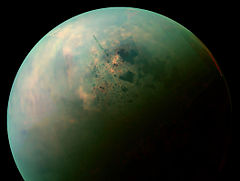
Titan is the largest moon of Saturn, the second-largest in the Solar System and larger than any of the dwarf planets of the Solar System. It is the only moon known to have a dense atmosphere, and is the only known object in space other than Earth on which clear evidence of stable bodies of surface liquid has been found.

Lacus Mortis is a hexagonal-shaped plain of basaltic lava flows in the northeastern part of the Moon's near face. It was formed as a floor-fractured crater during the pre-Imbrian epoch, then flooded during the late Imbrian period. This feature lies just to the south of the elongated Mare Frigoris, being separated by a slender arm of rugged ground and linked at the eastern extreme. To the south is the Lacus Somniorum, separated from this mare by the joined craters Plana and Mason, and a strip of uneven surface.

Ontario Lacus is a lake composed of methane, ethane and propane near the south pole of Saturn's moon Titan. Its character as a hydrocarbon lake was confirmed by observations from the Cassini spacecraft, published in the 31 July 2008 edition of Nature. Ontario Lacus has a surface area of about 15,000 square kilometers (5,800 sq mi), about 20% smaller than its terrestrial namesake, Lake Ontario in North America. In April 2012, it was announced that it may be more like a mudflat or salt pan.
Lake Hammar is a saline lake in southeastern part of Iraq within the Hammar Marshes. It has an area of 600–1,350 km2. Water level in the lake fluctuates, with maximum depths varying from 1.8 metres (winter) to 3.0 metres (spring). The lake is an important wetland site for birds. The native inhabitants are Marsh Arabs, some of whom occupy villages on artificial, floating islands.

Lakes of ethane and methane on Titan, Saturn's largest moon, have been detected by the Cassini–Huygens space probe, and had been suspected long before. The large ones are known as maria (seas) and the small ones as lacūs (lakes).
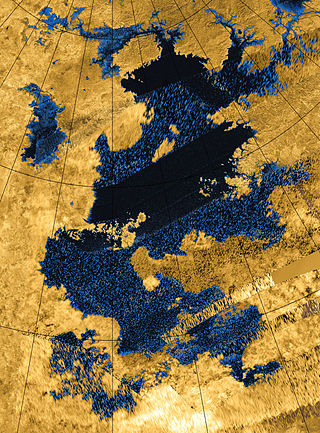
Kraken Mare is the largest known body of liquid on the surface of Saturn's moon Titan. It was discovered by the space probe Cassini in 2006, and was named in 2008 after the Kraken, a legendary sea monster. It covers an area slightly bigger than the Caspian Sea on Earth, making it the largest known lake in the Solar System.

Ligeia Mare is a lake in the north polar region of Titan, the planet Saturn's largest moon. It is the second largest body of liquid on the surface of Titan, after Kraken Mare. Larger than Lake Superior on Earth, it is mostly composed of liquid methane, with unknown but lesser components of dissolved nitrogen and ethane, as well as other organic compounds. It is located at 78° N, 249° W, and has been fully imaged by the Cassini spacecraft. Measuring roughly 420 km (260 mi) by 350 km (217 mi) across, it has a surface area of about 126,000 km2, and a shoreline over 2,000 km (1,240 mi) in length. The lake may be hydrologically connected to the larger Kraken Mare. Its namesake is Ligeia, one of the sirens in Greek mythology.

Jingpo Lacus is a lake in the north polar region of Titan, the planet Saturn's largest moon. It and similarly sized Ontario Lacus are the largest known bodies of liquid on Titan after the three maria. It is composed of liquid hydrocarbons. It is west of Kraken Mare at 73° N, 336° W, roughly 240 km long, similar to the length of Lake Onega on Earth. Its namesake is Jingpo Lake, a lake in China.
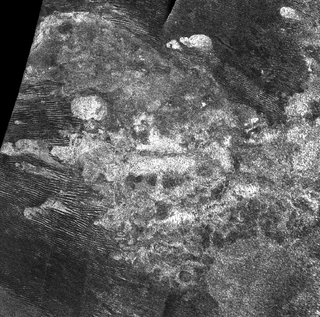
Erebor Mons is a mountain on Titan, the largest moon of the planet Saturn. It is located near Titan's equator, between 4–5° south and 35–36° west, centered on 4.97°S 36.23°W, in the western part of Quivira region. It is 40 km across, more than 1 km high, and has lobate flow features to its north and east. It is probably a cryovolcano. Erebor Mons is situated about 470 km to the north-northeast of a larger cryovolcanic construct, Doom Mons.

Bolsena Lacus is one of a number of hydrocarbon lakes found on Saturn's largest moon, Titan.
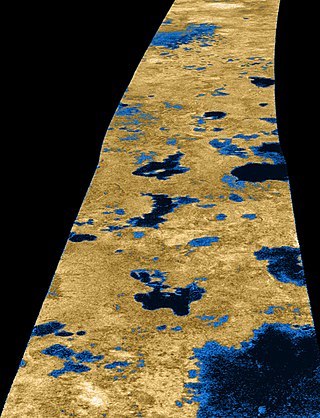
Neagh Lacus is one of a number of hydrocarbon lakes found on Saturn's largest moon, Titan. The lake is composed of liquid methane and ethane, and was detected by the Cassini space probe.

Sotonera Lacus is one of a number of hydrocarbon lakes found on Saturn's largest moon, Titan.
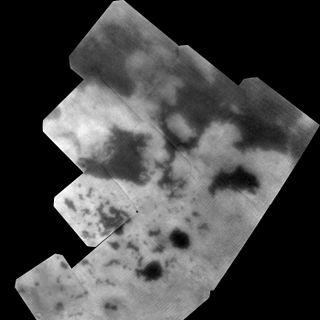
Woytchugga Lacuna is one of the largest lakes of Titan.

Feia Lacus is one of a number of hydrocarbon seas and lakes found on Saturn's largest moon, Titan. It was named in 2007 on the basis of data taken by the space probe Cassini.

Koitere Lacus is one of a number of hydrocarbon lakes found on Saturn's largest moon, Titan. The lake is composed of liquid methane and ethane, and was detected by the space probe Cassini.

Müggel Lacus is one of a number of hydrocarbon seas and lakes found on Saturn's largest moon, Titan.

Ladoga Lacus is a geographical feature on Saturn's largest moon, Titan, named after Lake Ladoga, Russia. It is one of a number of "methane lakes" found in Titan's north polar region.

Menrva is the largest crater on Titan, with a diameter of 392 kilometers. The crater is a heavily eroded double ringed impact basin, similar to the impact related features of Mars and Mercury. This is evident by Menrva's distinct lack of a central peak, indicating modification of the crater's surface since formation. It has been estimated that Menrva is approximately 2.8 kilometers deep.
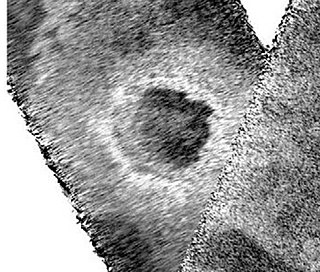
The Selk crater is a crater on Titan, a moon of Saturn, located at 7°N 199°W. It is a geologically young impact crater that measures approximately 90 kilometres (56 mi) in diameter.
